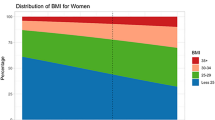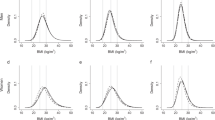Abstract
Background:
Research efforts have focused mainly on trends in obesity among populations, or changes in mean body mass index (BMI), without consideration of changes in BMI across the BMI spectrum. Examination of age-specific changes in BMI distribution may reveal patterns that are relevant to targeting of interventions.
Methods:
Using a synthetic cohort approach (which matches members of cross-sectional surveys by birth year) we estimated population representative annual BMI change across two time periods (1980 to 1989 and 1995 to 2008) by age, sex, socioeconomic position and quantiles of BMI. Our study population was a total of 27 349 participants from four nationally representative Australian health surveys; Risk Factor Prevalence Study surveys (1980 and 1989), the 1995 National Nutrition Survey and the 2007/8 National Health Survey.
Results:
We found greater mean BMI increases in younger people, in those already overweight and in those with lower education. For men, age-specific mean annual BMI change was very similar in the 1980s and the early 2000s (P=0.39), but there was a recent slowing down of annual BMI gain for older women in the 2000s compared with their same-age counterparts in the 1980s (P<0.05). BMI change was not uniform across the BMI distribution, with different patterns by age and sex in different periods. Young adults had much greater BMI gain at higher BMI quantiles, thus adding to the increased right skew in BMI, whereas BMI gain for older populations was more even across the BMI distribution.
Conclusions:
The synthetic cohort technique provided useful information from serial cross-sectional survey data. The quantification of annual BMI change has contributed to an understanding of the epidemiology of obesity progression and identified key target groups for policy attention—young adults, those who are already overweight and those of lower socioeconomic status.
This is a preview of subscription content, access via your institution
Access options
Subscribe to this journal
Receive 12 print issues and online access
$259.00 per year
only $21.58 per issue
Buy this article
- Purchase on Springer Link
- Instant access to full article PDF
Prices may be subject to local taxes which are calculated during checkout




Similar content being viewed by others
References
Finucane MM, Stevens GA, Cowan MJ, Danaei G, Lin JK, Paciorek CJ et al. National, regional, and global trends in body-mass index since 1980: systematic analysis of health examination surveys and epidemiological studies with 960 country-years and 9.1 million participants. Lancet 2011; 377: 557–567.
AIHW DT, Waters A-M . A Growing Problem: Trends and Patterns in Overweight and Obesity among Adults in Australia, 1980–2001. AIHW: Canberra, 2003.
Australian Bureau of Statistics. Australian Health Survey First Results, 2011-12 Australian Bureau of Statistics (cat. no. 4363.0.55.001). Canberra, 2012.
Levy DT, Mabry PL, Wang YC, Gortmaker S, Huang TT, Marsh T et al. Simulation models of obesity: a review of the literature and implications for research and policy. Obes Rev 2011; 12: 378–394.
Basu A . Forecasting distribution of body mass index in the United States: is there more room for growth? Med Decis Making 2010; 30: E1–E11.
Flegal KM, Carroll MD, Kit BK, Ogden CL . Prevalence of obesity and trends in the distribution of body mass index among US adults, 1999-2010. JAMA 2012; 307: 491–497.
Razak F, Corsi DJ, Subramanian SV . Change in the body mass index distribution for women: analysis of surveys from 37 low- and middle-income countries. PLoS Med 2013; 10: e1001367.
Walls HL, Wolfe R, Haby MM, Magliano DJ, de Courten M, Reid CM et al. Trends in BMI of urban Australian adults, 1980–2000. Public Health Nutr 2010; 13: 631–638.
Dunstan DW, Zimmet PZ, Welborn TA, Cameron AJ, Shaw J, de Courten M et al. The Australian Diabetes, Obesity and Lifestyle Study (AusDiab)–methods and response rates. Diabetes Res Clin Pract 2002; 57: 119–129.
Peeters A, Magliano DJ, Backholer K, Zimmet P, Shaw JE . Changes in the rates of weight and waist circumference gain in Australian adults over time: a longitudinal cohort study. BMJ Open 2014; 4: e003667.
Deaton A . Panel data from a time series of cross‐sections. J Econom 1985; 30: 109–126.
Lean ME, Katsarou C, McLoone P, Morrison DS . Changes in BMI and waist circumference in Scottish adults: use of repeated cross-sectional surveys to explore multiple age groups and birth-cohorts. Int J Obes (Lond) 2013; 37: 800–808.
Robinson WR, Keyes KM, Utz RL, Martin CL, Yang Y . Birth cohort effects among US-born adults born in the 1980s: foreshadowing future trends in US obesity prevalence. Int J Obes (Lond) 2013; 37: 448–454.
National Heart Foundation of Australia. Risk Factor Prevalence Study, 1980 Canberra: Social Science Data Archives, The Australian National University, 2001.
National Heart Foundation of Australia. Risk Factor Prevalence Survey, 1989 Canberra: Social Science Data Archives, The Australian National University, 2001.
Australian Bureau of Statistics 1995 National Nutrition Survey Users' guide 1996. Commonwealth of Australia, Australian Bureau of Statistics (cat. no. 4801.0) Canberra.
Australian Bureau of Statistics. National Health Survey: Users' Guide, 2007–08. Australian Bureau of Statistics (cat. no. 4363.0.55.001); Canberra, 2009.
Mejer L, Siermann C . Income poverty in the European Union: Children, gender and poverty gaps. Stat Focus 2000. Population and Social Conditions. Theme 3,12. Eurostat, Luxembourg.
Lilja M, Eliasson M, Stegmayr B, Olsson T, Soderberg S . Trends in obesity and its distribution: Data from the northern Sweden MONICA survey, 1986–2004. Obesity 2008; 16: 1120–1128.
Ball K, Brown W, Crawford D . Who does not gain weight? Prevalence and predictors of weight maintenance in young women. Int J Obes Relat Metab Disord 2002; 26: 1570–1578.
Allman-Farinelli MA, Chey T, Bauman AE, Gill T, James WP . Age, period and birth cohort effects on prevalence of overweight and obesity in Australian adults from 1990 to 2000. Eur J Clin Nutr 2008; 62: 898–907.
Whitlock G, Lewington S, Sherliker P, Clarke R, Emberson J, Halsey J et al. Body-mass index and cause-specific mortality in 900 000 adults: collaborative analyses of 57 prospective studies. Lancet 2009; 373: 1083–1096.
(ANPHA) ANPHA. State of Preventive Health 2013.Report to the Australian Government Minister for Health. report. Canberra: 2013.
Sperrin M, Marshall AD, Higgins V, Buchan IE, Renehan AG . Slowing down of adult body mass index trend increases in England: a latent class analysis of cross-sectional surveys (1992-2010). Int J Obes (Lond) 2014; 38: 818–824.
Kahn HS, Cheng YJ . Longitudinal changes in BMI and in an index estimating excess lipids among white and black adults in the United States. Int J Obes (Lond) 2008; 32: 136–143.
Devaux M, Sassi F . Social inequalities in obesity and overweight in 11 OECD countries. Eur J Public Health 2013; 23: 464–469.
Ball K, Crawford D . Socioeconomic status and weight change in adults: a review. Soc Sci Med 2005; 60: 1987–2010.
Backholer K, Mannan HR, Magliano DJ, Walls HL, Stevenson C, Beauchamp A et al. Projected socioeconomic disparities in the prevalence of obesity among Australian adults. Aust N Z J Public Health 2012; 36: 557–563.
Tanamas SK, Shaw JE, Backholer K, Magliano DJ, Peeters A . Twelve-year weight change, waist circumference change and incident obesity: the Australian diabetes, obesity and lifestyle study. Obesity (Silver Spring) 2014; 22: 1538–1545.
Bastien M, Poirier P, Lemieux I, Despres JP . Overview of epidemiology and contribution of obesity to cardiovascular disease. Prog Cardiovasc Dis 2014; 56: 369–381.
Adams KF, Leitzmann MF, Ballard-Barbash R, Albanes D, Harris TB, Hollenbeck A et al. Body mass and weight change in adults in relation to mortality risk. Am J Epidemiol 2014; 179: 135–144.
Acknowledgements
We thank the Australian Bureau of Statistics for access to the National Nutrition and National Health Surveys and the National Heart Foundation's Risk Factor Prevalence Study Committee and the Australian Social Science Data Archive for access to the Risk Factor Prevalence Studies. AH was supported by National Health and Medical Research Council grant (571372). The research was supported in part by the Victorian Government’s OIS Program. EG and KB were supported by the ARC Linkage grant (LP120100418) and an Australian National Preventive Health Agency grant (188PEE2011), EG was supported by an Australian Postgraduate Award, KB was supported by a Post doctoral Research Fellowship from the National Heart Foundation of Australia (PH 12M6824), AP was supported by a National Health and Medical Research Council Career Development Fellowship (1045456) and the Baker IDI.
Author information
Authors and Affiliations
Corresponding author
Ethics declarations
Competing interests
The authors declare no conflict of interest.
Additional information
Supplementary Information accompanies this paper on International Journal of Obesity website
Rights and permissions
About this article
Cite this article
Hayes, A., Gearon, E., Backholer, K. et al. Age-specific changes in BMI and BMI distribution among Australian adults using cross-sectional surveys from 1980 to 2008. Int J Obes 39, 1209–1216 (2015). https://doi.org/10.1038/ijo.2015.50
Received:
Revised:
Accepted:
Published:
Issue Date:
DOI: https://doi.org/10.1038/ijo.2015.50
This article is cited by
-
Changes over time in latent patterns of childhood-to-adulthood BMI development in Great Britain: evidence from three cohorts born in 1946, 1958, and 1970
BMC Medicine (2021)
-
The effect of body mass index and creatinine clearance on serum trough concentration of vancomycin in adult patients
BMC Infectious Diseases (2020)
-
Impact of overweight, obesity and severe obesity on life expectancy of Australian adults
International Journal of Obesity (2019)
-
Trends in the distribution of body mass index and waist circumference among South Korean adults, 1998–2014
European Journal of Clinical Nutrition (2018)
-
Modelling obesity trends in Australia: unravelling the past and predicting the future
International Journal of Obesity (2017)



